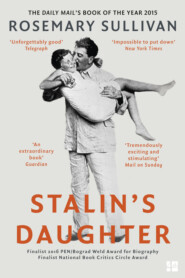
Полная версия:
Stalin’s Daughter: The Extraordinary and Tumultuous Life of Svetlana Alliluyeva
Though outwardly cool, Rayle himself was deeply anxious. He was convinced that, as soon as they discovered her missing, the Soviets would definitely insist that she be handed over. If she was discovered at the airport, the Indian police would arrest her, and there would be nothing he could do. He felt the consequences for her would be grave.15 Execution would have been the old Stalinist style, but her father had been dead fourteen years. Still, the current Soviet government took a hard line on defectors, and imprisonment was always a possibility. When the classical dancer Rudolf Nureyev defected in 1961, he was sentenced in absentia to seven years’ hard labor. In Rayle’s mind must also have been the recent trials of the writers Andrei Sinyavsky and Yuli Daniel. In 1966 they’d been sentenced to labor camps for their “anti-Soviet” writings, and they were still languishing there. The Kremlin would not risk a public trial of Svetlana, but she might disappear into the dark reaches of some psychiatric institution. Svetlana, too, must have had this in mind. Sinyavsky was an intimate friend. At least she knew that, were she apprehended, she would never be allowed out of the Soviet Union again.
The Qantas flight to Rome landed punctually, but Rayle’s relief soon turned to dread as he heard the announcement that the flight would be delayed. The plane had developed mechanical difficulties. The two sat in the departure lounge waiting as minutes turned to hours. Rayle looked at Svetlana. She, too, had begun to be agitated. To cope with the mounting tension, Rayle got up periodically to check the arrivals desks. He knew that the regular Aeroflot flight from Moscow arrived at 5:00 a.m. and a large delegation from the Soviet Embassy always came to greet the diplomatic couriers and the various dignitaries arriving or departing. Members of the Aeroflot staff were already beginning to open their booth. Finally, the departure for Rome was announced. At 2:45 a.m. the Qantas flight for Rome was airborne at last.16
As they were in midair, a cable about the defector arrived at the American Embassy in New Delhi. In Washington Donald Jameson, who served as CIA liaison officer to the State Department, had informed Deputy Undersecretary of State Foy Kohler of the situation. Kohler’s reaction was stunning—he exploded: “Tell them to throw that woman out of the embassy. Don’t give her any help at all.”17 Kohler had recently served as American ambassador to the USSR and believed that he had personally initiated a thaw in relations with the Soviets. He didn’t want the defection of Stalin’s daughter, especially coinciding with the fiftieth anniversary of the Russian Revolution, muddying the waters. When the embassy staff read the flash cable rejecting Svetlana’s appeal for asylum, they replied, “You’re too late. They’ve gone. They’re on their way to Rome.”18
The staff failed to check the status of the Qantas flight. Had they discovered that Svetlana and Rayle were sitting for almost two hours in the airport lounge and could have been recalled, Svetlana would have been driven back to the embassy and “kicked out.” The whole course of her life would have gone very differently. But Svetlana’s life always seemed to dangle on a thread, and chance or fate sent her one way rather than another. She would come to call herself a gypsy. Stalin’s daughter, always living in the shadow of her father’s name, would never find a safe place to land.
Chapter 1
That Place of Sunshine
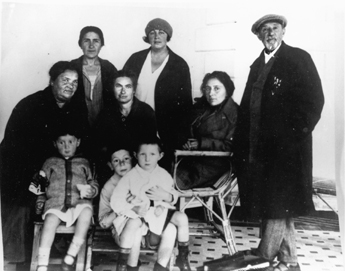
Family group, c. 1930. Standing, from left: Mariko and Maria Svanidze, Stalin’s sisters-in-law from his first marriage. Seated in center, from left: Alexandra Andreevna Bychkova (Svetlana’s nanny), Nathalie Konstantinova (governess), and Svetlana’s maternal aunt Anna Redens. Front row, from left: Svetlana and her brother, Vasili, with Nikolai Bukharin’s daughter sitting on his knee. Standing on right: Sergei Alliluyev, Svetlana’s maternal grandfather.
(Svetlana Alliluyeva private collection; courtesy of Chrese Evans)
Over her lifetime, Svetlana often would take out the photographs from her early childhood and muse over them, experiencing that lovely, brutal nostalgia of photos trapping time. Her mother had always been the one with the camera taking the pictures. Everyone at the family gatherings was so young and alive, so simple and ebullient, wearing a picnic face. The first six and a half years of her life, until her mother’s death in 1932, were, in Svetlana’s mind, the years of sun. She would speak of “that place of sunshine I call my childhood.”1
Who can live without personal retrospect? We will always glance back to our childhood, for we are shaped deep in our core by the impress of our parents, and we will always wonder how that molding determined us. Svetlana willfully believed in her happy childhood, even as she gradually understood that it was secured by untold bloodshed. What was it about this strange childhood that she would always turn to it for solace?
Svetlana grew up in the Kremlin, the citadel of the tsars, a walled fortress on the edge of the Moskva River, almost a small autonomous village but with imposing towers, cathedrals, and palaces centered on Cathedral Square with massive gates opening onto Red Square and the city beyond. One might think this royal fortress was impossibly grand, but when she was born there in 1926, the second child of Joseph and Nadezhda (“Nadya”) Stalin, the Russian Revolution was only nine years old. The public would always see her as the princess in the Kremlin, but her father’s Bolshevik discipline dictated a relatively modest life.
The Stalins lived in the old Poteshny Palace, a three-story building erected in 1652. It was known as the Amusement Palace and served as a theater for comic performances until, in the nineteenth century, it housed the offices of the Okhrana, the tsar’s secret police. The Poteshny retained its elegant theatrical chandeliers and carpeted staircase, up which the Stalins climbed to their gloomy, high-ceilinged apartment on the second floor.
Svetlana remembered that apartment: “There was [a room] for the governess, and a dining room large enough to have a grand piano in it. . . . In addition there was a library, Nadya’s room, and Stalin’s tiny bedroom in which stood a table with telephones.”2 There were two rooms for the children (she shared hers with her nanny), a kitchen, the housekeeper’s room, and two bathrooms. Wood-burning stoves heated all the rooms. As she described it, “it was homely, with bourgeois furniture.” Families of other Bolshevik leaders lived across the lane in the Horse Guards building and casually dropped by.
In keeping with the ideology of the Party, there was no private property. Everything belonged to the state, down to the wineglasses and silverware, which meant, in the end, that everything was up for grabs. In the early days, even Party members had ration cards for food, but their use was hypothetical. In a country where the populace was starving, there was always enough food for the intimate soirees when the Party magnates gathered in one another’s apartments. All the leaders were assigned one of the country dachas abandoned by the rich upper classes who had fled in the early days of the Revolution.
When Svetlana was born, on February 28, she entered an already crowded household. Her brother Vasili had been born five years earlier, on March 21, 1921. The story went around that Nadya, demonstrating Bolshevik austerity and an iron will, had walked to the hospital after dinner to deliver her son. Once the ordeal was over, she phoned home to congratulate Stalin.3 Svetlana’s half brother Yakov Djugashvili, the child of Stalin’s first marriage, had also joined the household in 1921. Yakov was nineteen years older than Svetlana and would become her champion until his brutal death in a Nazi POW camp.
Family life had a Chekhovian quality, with relatives wandering into and out of the Kremlin apartment. There were two branches of the family: the Alliluyevs and the Svanidzes. Nadya’s own family constantly visited. By now the large clan included Nadya’s parents, Olga and Sergei Alliluyev; her brothers, Fyodor and Pavel; Pavel’s wife, Eugenia (“Zhenya”); her sister, Anna; and Anna’s husband, Stanislav Redens. All the family members would come to play tragic parts in the Stalin narrative.
The Svanidze branch arrived from Georgia in 1921, shadows out of Stalin’s past. In 1906, when the Georgian-born Joseph Stalin was still just a local agitator fomenting revolution under the code name Soso, he married the sister of a school friend and fellow underground revolutionary, Alexander (“Alyosha”) Svanidze. In those prerevolutionary days, when the triumph of the Bolsheviks seemed impossibly distant, Svanidze’s three sisters ran an haute couture fashion house in Tiflis (Tbilisi), called Atelier Hervieu. The waiting room was always full of counts, generals, and police officers. While the sisters fitted the dress of a general’s wife in one room, the revolutionaries discussed their plans for sabotage next door and hid their secret documents inside the stylish mannequins.4
The youngest sister, the exquisitely lovely Ekaterina Svanidze, whom everyone called Kato, fell in love with the mysterious and witty Comrade Soso. By then he was head of the Bolshevik faction in Tiflis, and it was no surprise that the tsar’s secret police often came calling. Kato was pregnant within months of their marriage and gave birth to Yakov in March 1907. She contracted typhus shortly afterward. The family reported that Kato, just twenty-two, died in Soso’s arms on November 22, 1907. At the funeral, a distraught Soso threw himself into the grave with the coffin, and then he disappeared for two months.5
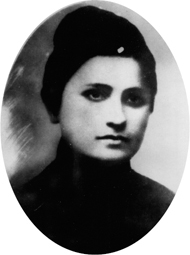
Stalin’s first wife, Ekaterina “Kato” Svanidze, who died in 1907.
(Svetlana Alliluyeva private collection; courtesy of Chrese Evans)
Looking back, Stalin would tell his daughter, Svetlana, that Kato “was very sweet and beautiful: she melted my heart”6—but not quite enough, it seemed, for him to assume responsibility for their infant son. He abandoned Yakov to the care of his mother-in-law and the Svanidze sisters. One of the few contacts that the family had with Stalin was a letter from Siberia during one of his pre-Revolution exiles, asking them to send him wine and jam.7
On a visit to Georgia in 1921, the Svanidze family encouraged Stalin to bring his fourteen-year-old son back with him to Moscow. Stalin’s brother-in-law, Alyosha Svanidze, who’d been so close to Stalin in his early revolutionary days, also came, bringing along his sisters, Mariko and Sashiko, thus joining the Kremlin elite. A Europeanized Georgian, Alyosha had studied in Germany and was something of a dandy. His beautiful, flamboyant wife, Maria, from a wealthy Jewish family, who had sung in the Tiflis opera before her marriage, came with him. It would have been much safer for them had they all stayed in Georgia.
Artyom Sergeev, Nadya and Stalin’s adopted son, occasionally visited. His father had been killed in 1921 while testing a new high-speed train powered by an airplane engine. Though Artyom’s mother was still alive, Stalin adopted the boy, in keeping with the Bolshevik custom of assuming the care of orphans of Party members. Artyom became the bosom buddy of Svetlana’s brother Vasili.8
The only person who was always absent from these family gatherings was Stalin’s mother, Ekaterina, affectionately known as Keke. Nadya would write her mother-in-law encouraging letters: “Things here seem to be all right, we’re very well. The children are growing up. . . . Altogether we have terribly little free time, Joseph and I. . . . Still, I’m not complaining and so far, I’m coping with it all quite successfully.”9
Though she had visited the Kremlin once to meet Nadya, Stalin’s widowed mother refused to abandon her beloved Georgia. She lived in the old Viceroy’s Palace in Tiflis, where she chose to occupy a room on the ground floor next to the servants’ quarters, while the top floors were reserved for social functions.
To Svetlana, who seems to have met her only once in Georgia, her paternal grandmother, Keke, was a stranger and therefore rarely a part of her family mythology. Svetlana knew the stories: that her grandfather Vissarion “Beso” Djugashvili had been a cobbler who, in his drunken rages, had beaten his son brutally until Keke finally kicked him out. Keke had scraped together the money to send Joseph to the Gori Church School and then on to the Tiflis Seminary, intending him to become a priest. Svetlana always said that the notorious brutality of the Orthodox priests, who punished their students with solitary confinement for days in dungeonlike cells, had shaped her father’s penchant for cruelty.
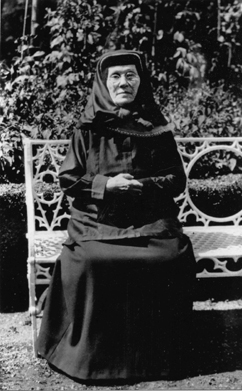
Stalin’s mother, Ekaterina “Keke” Djugashvili, who refused to leave her native Georgia to visit Moscow.
(Svetlana Alliluyeva private collection; courtesy of Chrese Evans)
As an adult, Svetlana would only sparingly comment on her father to friends, but one of the things she did say was that the only person her father ever feared was his mother.10 But such was the mystification in which her father cloaked himself that even his daughter did not know his real birth date. Stalin was actually born on December 6, 1878, a year earlier than he claimed.11 In keeping with his habit of inventing much of his own biography, Stalin chose December 21, 1879, as his official birthday. The family always celebrated on this day.
This, then, was Svetlana’s intimate family. She maintained that at the center of it all was her mother, Nadya, who died when Svetlana was six and a half. What does a child remember of her mother at such an age? By her sudden disappearance, Nadya became a key to understanding Svetlana’s emotional life. The photograph Svetlana most loved was the one of her mother holding her when she was an infant. It was proof that her mother loved her.
Svetlana couldn’t remember her mother’s face, but she could remember the smell of her Chanel perfume, which Nadya wore despite Stalin’s disapproval. Her mother would come into her room to say good night, would touch her, then touch her pillow, and she would fall asleep engulfed in perfume.12 But she could barely remember her mother kissing her or stroking her hair. Her mother was a strict disciplinarian. Hearing from Vasili, her tattletale older brother, that she’d been naughty, Nadya wrote to her daughter from her vacation in Sochi:
Hello, Svetlanochka!
I had a letter from Vasya [Vasili] saying that my little girl is carrying on and being terribly naughty. I hate getting letters like that. . . . When Mama went away, her little girl made a great many promises, but now it turns out she isn’t keeping them. Please write and let me know whether you’ve decided to be good or not. You decide. You’re a big girl and are able to think for yourself. Are you reading anything in Russian? I’m waiting to hear from you.
Your Mama 13
This letter, written when Svetlana was four or five, was the only letter she ever received from her frequently absent mother.
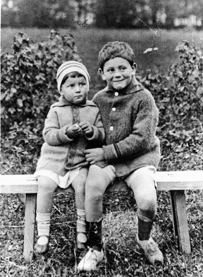
Svetlana, age six, with her eleven-year-old brother, Vasili, in a photo from 1932 taken before their mother committed suicide on November 9.
(Svetlana Alliluyeva private collection; courtesy of Chrese Evans)
Svetlana felt she was a quiet, obedient child. Three decades later, she could write: “[Mother] expected a good deal of me,” still hurt that there were few memories of tenderness in her mother’s treatment of her.14 But there was one thing in particular that she did recall. It was the memory of her mother drawing a little square over her heart with her finger and telling her, “That is where you must bury your secrets.”15 In the backbiting political world of the Kremlin, Nadya kept her feelings and her secrets hidden, something her daughter, who would become notorious for her emotional outbursts, did not emulate.
As a child, of course Svetlana thought her mother was beautiful. In retrospect, she believed her mother showed her love through her dedication to her children’s education, which she took in hand from their earliest childhood and which, for Svetlana, made her the model of the dedicated mother.
Nadya is an elusive figure in the Stalin universe. She was a sixteen-year-old girl when, according to the family and to her daughter, she fell madly, passionately in love with the thirty-nine-year-old Stalin, already Lenin’s loyal ally and a star in the Bolshevik firmament. Much to her parents’ annoyance, she ran off with him in 1918 to join the Revolution, becoming his secretary. Nadya was headstrong, stubborn, puritanical, and idealistic. To outsiders she appeared cold, but this exterior hid a passionate and volatile temperament.
Nadya’s warmth, as well as her frustration, surfaces in a letter to the aunt of her stepson Yakov, Maria Svanidze, of whom she was clearly very fond. Maria and her husband, Alexander, were then living in Berlin, where he was working for the Soviet Bank for Foreign Trade. Nadya wrote the letter just before the birth of Svetlana, who, despite her mother’s ambivalence about the pregnancy, obviously treasured the letter, translating it into English herself and saving it:
JANUARY 11, 1926
Dear Maroussya
You write that you feel bored. You know, my dear, it’s the same thing everywhere. I have nothing to do with anyone in Moscow. Sometimes that looks even strange: in so many years not to develop close friendships, but that depends on character. It is strange that I feel much closer to non–party members, I mean women. This public is much simpler to get along with.
I regret that I have again took [sic] upon myself strong family bonds [here Svetlana added a footnote: “N. S. Allilueva was expecting her daughter Svetlana at that time”]. This is not so easy in our days, because there appeared to be so many new prejudices, like if you are not working you are a “baba,”* although perhaps one does not work only because one does not have due qualifications. And now when I am going to be with family business, it is impossible to think about one’s qualifications. I advise you, dear Maroussya, to obtain some skills for Russia, while you are abroad. I am serious. You simply cannot imagine how unpleasant it is to work simply for earnings, doing any work; one must have a specialty, specialization, which would liberate you from dependence on others. . . .
Well, my dear Maroussya, do not feel lonely, do obtain necessary qualifications and come to us next time. We shall all be very happy to see you. Joseph is asking me to give you his love. He has very good feelings toward you (he says “she is a smart baba”). Do not get angry—that is his usual way to treat us, women. . . .
I kiss you and goodbye,
Nadya 16
Nadya was fed up with being a shadow in the Kremlin and was determined not to be a baba. As soon as Svetlana was born, Nadya, then twenty-five, searched for a nanny to care for her infant daughter so that she would be free to pursue her own education. After interviewing prospective candidates, she settled on Alexandra Andreevna Bychkova.
Alexandra Andreevna knew about loyalty. She had been born in 1885 on an estate in Ryazan, southeast of Moscow, and worked as maid, cook, nurse, and housekeeper until she joined the Saint Petersburg household of Nikolai Yevreinov, a theater director and critic, a member of the prerevolutionary liberal intelligentsia. The Yevreinov family taught the illiterate Alexandra Andreevna to read and write. When the outbreak of the Revolution forced them to flee to Paris, they invited her to accompany them, but she refused to leave the motherland. During the famines of the early 1920s, she fled, with her one remaining son (the other had died of starvation), to Moscow, where Nadya Stalina discovered and hired her. Svetlana’s adopted brother, Artyom Sergeev, would say that Alexandra Andreevna was “an absolutely wonderful nanny.” She reminded him of Pushkin’s faithful nanny, Arina Rodionova.17
Alexandra Andreevna was a remarkable storyteller who threaded her conversation with Russian proverbs, filling the children’s ears with tales of her village and of her “theater” days in Saint Petersburg. Her greatest gift was her capacity to keep silent as she weathered all the vicissitudes over the years in the Stalin household. Svetlana would say of her, “For me, during my whole life, she was an example of calmness, hard work, warmth, some kind of epic tranquility, and an unending optimism.”18
Nadya left Svetlana’s nanny strict instructions never to let her charge be idle. Svetlana remembered her nanny taking her to preschool for music lessons with twenty other children. Svetlana sang in a children’s chorus and was soon taught to read and transcribe music and play the piano. Alexandra Andreevna stayed with Svetlana for thirty years until her death in 1956, serving as nanny for Svetlana’s own children. If there was any ethical grounding for Svetlana in the morally ambiguous Stalin universe, it came from her nanny, Alexandra Andreevna. “If it hadn’t been for the even, steady warmth given off by this large and kindly person,” Svetlana later wrote, “I might long ago have gone out of my mind.”19
In 1928, when Svetlana was two, Nadya enrolled at the Industrial Academy to study synthetic fibers, a new branch of chemistry. There were also endless Party meetings, and what free time Nadya had she spent with Stalin. She hired tutors to oversee her children’s education, while she was mostly absent.
As Svetlana put it with some resentment, “It was not the thing at that time for a woman, especially a woman Party member, to spend much time with her children.”20 All the Kremlin wives had Party jobs. In their spare time, some took up tennis. There were tennis courts and croquet sets on those dacha lawns. It was an uncanny replication of the old tsarist aristocracy’s way of life.
Nadya hired a German housekeeper from Latvia, Carolina Til, to run the Kremlin apartment and left everything to her German efficiency. She also hired a governess for Svetlana and a male tutor for Vasili, much as the tsars had done. Svetlana learned to read and write German and Russian by the time she was six.
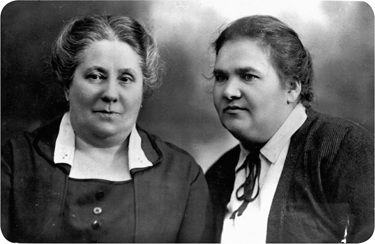
From left: Carolina Til, the housekeeper, and the nanny Alexandra Andreevna Bychkova.
(Svetlana Alliluyeva private collection; courtesy of Chrese Evans)
The life of all the children in the numerous Kremlin apartments followed a similar routine, run by governesses and tutors. But it was not all discipline. Stepan Mikoyan, whose father was an Old Bolshevik and a Soviet statesman, one of the few who survived Stalin’s purges, lived in the Horse Guards building and used to play with Vasili and Svetlana. He remembered afternoons when all of the children of government officials, including the staff—there must have been thirty or forty children—raced through the gardens. Svetlana was a tomboy and fearlessly climbed the Tsar’s Cannon, the largest cannon in the world, just like everybody else.21
There were rollicking children’s parties at which twenty or thirty children might read a fable by the nineteenth-century writer Ivan Andreyevich Krylov, imitating the animals and wearing actual bearskins. But they would also chant satirical couplets about “political double-dealers.” Their parents would be the audience, and even Stalin might be there, a passive witness, as was his habit, watching indulgently from the sidelines. “Once in a while,” his daughter would remark laconically, “he enjoyed the sounds of children playing.”22



